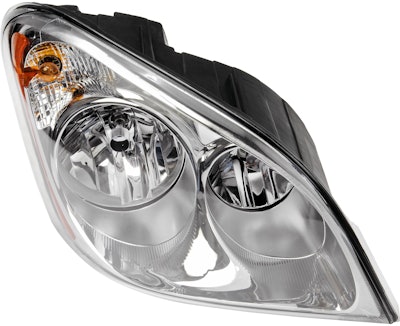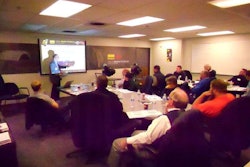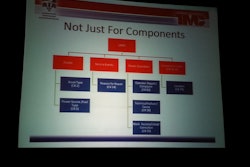
“Fleets are becoming very cognizant of lighting and the impact it has on their CSA scores,” says Tim Walker, senior vice president, worldwide sales at Truck-Lite.
The most common violations in the FMCSA’s Compliance Safety Accountability (CSA) vehicle maintenance BASIC are lighting related. That means aftermarket businesses that emphasize lighting can not only grow their sales, they also can help improve roadway safety.

Lighting sales in the aftermarket today are dominated by two bulb styles, incandescent and LED. While the former is waning in popularity and the latter is gaining prominence, carrying both lighting styles remains the best way to service today’s customers, suppliers say.
There are still too many vehicle owners using both product types to exclusively offer one.
Incandescent bulbs have been the primary method of lighting in the commercial vehicle aftermarket for decades. An incandescent light bulb produces illumination by heating a filament wire until it glows.
Similar to the round light bulbs commonplace in residential lighting, incandescent vehicle lighting’s biggest selling point in the marketplace remains its affordability, familiarity and accessibility.
“There’s still a significant cost benefit to the incandescent products,” says Doug Will, product manager – heavy-duty products at Dorman HD Solutions.
Dorman currently offers a wide selection of aftermarket head lamps and lamp assemblies, all of which operate using incandescent bulbs.

“When you get into the collision market, some of [the new LED headlamps] are not serviceable in the way incandescent lamps are,” he says. “Some aren’t serviceable at all.”
But incandescent bulbs offer both a problem and solution when addressing CSA violations related to stop/turn/tail lamp failures.
Tom Draper, marketing manager at Grote Industries, says one of the biggest draw- backs for fleets when spec’ing incandescent bulbs today is their life cycle. Because they rely on an extremely sensitive component (filament)
to work, it doesn’t take much road trauma to knock one out.
“Any sort of vibration or hard contact can put one out,” he says. And because incandescent bulbs have just one light source, any breakdown is a total failure, adds Brett Johnson, president and CEO at Optronics International.
But when hooked with a CSA violation for an inoperative lamp, Johnson says some fleets still return to their old incandescent mainstays.
Though the price discrepancy isn’t as extreme as headlamps, incandescent stop/turn/tail lamps are still cheaper than their LED counterparts. And that upfront cost advantage is well known in the marketplace, says Tim Gilbert, corporate director of heavy-duty sales at Peterson Manufacturing.

“In those situations they grab the [incandescent] replacement bulb … it’s cheaper at the time, but will end up costing more over the long haul.”
“People see the lower cost up front and don’t realize they are going to have to replace that bulb more over the life of the vehicle,” adds Brad Van Riper, chief technical officer at Truck-Lite.
That life-cycle advantage is the top selling point for newer LED stop/turn/tail lamp technology. Short for Light- Emitting Diode, LED works through electroluminescence within a bulb to emit light.
An aftermarket LED light typically has hundreds, if not thousands, of diodes emitting light at the same time, which creates a smoother, brighter and longer-lasting light, Draper says.
Gilbert adds the difference between the lighting styles is quite clear when displayed side-by-side. LED lights burn brighter and are visible from a much longer distance. Will adds that LEDs also require less electricity and operate at a lower temperature.
They’re more rugged, too, says Van Riper. “They’re much more resistant to shock and vibration.”
That life cycle is an important selling point when sitting down with a prospective customer, says Draper, because on average LED lamps are several times more expensive than an incandescent bulb.
In promoting its LED line to fleet customers and distributors, Draper says Grote likes to qualify those additional upfront costs as an investment.
“You’re looking at three times the cost for 10 times the light life and quality,” adds Johnson. “When you look at it like that, it’s a worthwhile sell.”
But the suppliers note there is still a place in the aftermarket for the incandescent bulb. Today’s LED manufacturers are still of- fering incandescent lamps in the marketplace, and have customers that remain loyal to them.
Will says that’s helped keep Dorman in the incandescent manufacturing sector. The company has researched adding LED product lines in other areas, but still sees the incandescent headlamp market remaining viable moving forward, he says.
“We’re going to see more [LED headlamps] as prices change, but I don’t think that market is going to completely switch,” he says.
The key, Johnson says, is ensuring customers know the instant a bulb is out that it needs to be fixed. Because ultimately a light’s number one job is to alert other vehicles to its actions, and both bulb options still do that.
“Lighting is a major issue within CSA,” he says. “People don’t want to get dinged [by violations].”










